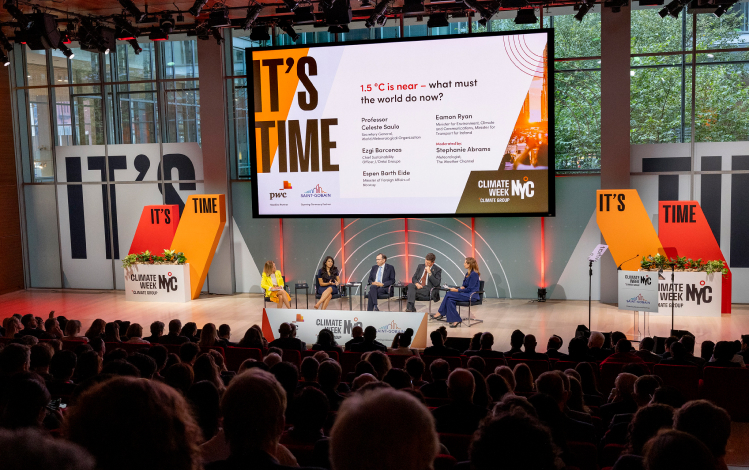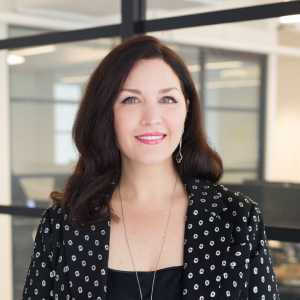

Navigating UNGA and Climate Week NYC: A view from the ground
It was a bustling week in New York as international heads of state, business leaders, entrepreneurs and other key influencers streamed into the city to attend events, speak on panels and network with other stakeholders at the annual opening of the UN General Assembly (in its 79th year) and Climate Week NYC, which was started in 2009 by the international nonprofit Climate Group.
There are hundreds of events — both official and nonofficial — that take place each year across the five boroughs of the city, making it impossible to do more than scratch the surface of the discussions taking place, the compelling programming to listen to, and the opportunities to interact with leaders discussing the biggest opportunities and challenges facing people and our planet today. It is both inspiring and overwhelming every year.
As Joel Makower, chairman and co-founder of GreenBiz (now Trellis) advises for anyone attending: “It all may seem intimidating, especially for newbies, so my counsel is simple: Just show up.”
I attended my first UNGA in 1999 while working at the press office of the United Nations, and it has been fascinating to observe how these events have evolved over the past 25 years. (See some of my personal insights here.)
The biggest change? UNGA used to be something that was largely followed and attended by government leaders, international policy wonks and UN watchers. Today, and accelerated by the establishment of Climate Week NYC 15 years ago, this week in September has become a hub where government leaders, CEOs, entrepreneurs and venture capitalists mingle with artists, musicians and social media influencers at a cornucopia of public and private events. It’s an important takeaway: Combating climate change and environmental degradation and achieving the SDGs (adopted at the UN General Assembly in 2015) require a whole-of-society approach; therefore, it is essential that stakeholders and decision-makers from all parts of society get involved.
Here are five additional observations from the ground in New York this year and some things to think about for next year:
Compelling programming from major media outlets
Top-tier media entities have programming throughout the week, including Axios, the Wall Street Journal, Semafor and the New York Times. Many of these events can be attended in-person for free (pending registration and approval), which is a great way to hear from a wide array of prominent business, civil society and government leaders and network with fellow attendees. Furthermore, these events tend to have a drop-in/drop-out approach; just because you sign up for WSJ House (which had three full days of programming this year) does not mean you are obligated or expected to attend all sessions. Pick and choose the ones that are most relevant to you.
One standout for me this year was an Axios event geared toward communicators and how we navigate communicating around sustainability and social issues among rising ESG and DEI backlash. As one of the speakers at the event, Ralph Lauren’s chief global impact and communications officer Katie Ioanilli, noted: “There are plenty of examples where companies, brands, leaders have stumbled because they were using language to make a point that was perhaps divisive or not aligned to who they are as a brand. It’s less about reacting to outside noise and more about aligning the commitments to your business and its mission or values.”
Securing a speaking role requires a paid sponsorship or being a well-established senior leader
There is no shortage of very high-profile people in town each year, and that abundance of riches means that event organizers have a lot of choices regarding who they invite to be panelists. Editorial invites usually go to C-suite executives, but there are sometimes options to delegate to lower-level executives and subject-matter experts. One way to guarantee a speaking role for your client is through paid sponsorship, which should be considered if funding is available and you need a guaranteed role for an executive.
Starting outreach to your media contacts and event organizers early (around April or May) is also a smart strategy for editorial options. If you are able to secure a speaking role at a media house, that can often result in earned coverage as they will have reporters from the outlet covering highlights from the panels (see examples from WE client Microsoft here and here).
Sharing news during UNGA or Climate Week presents a high bar to overcome
Between the hundreds of events taking place in parallel and a steady stream of heads of state addressing the United Nations throughout the week, it is a very noisy time to try to share news unless you have something big. Many companies and organizations choose to share news in the previous week so that they can pull through that news at any events or panels they are participating in.
It is also possible to set up targeted one-on-one meetings with reporters, which can result in coverage. This is a tactic WE employed for Microsoft this year as Microsoft’s Chief Sustainability Officer Melanie Nakagawa and head of energy Bobby Hollis spoke with Evan Halper of the Washington Post and Heather Clancy of Trellis about how Microsoft is working to make data centers more sustainable amid growth of generative AI and its related power needs.
Networking is arguably the most important activity
Although your client may be focused on media coverage, I would argue that the most important aspect of attending UNGA or Climate Week-related events is the people you meet and the connections made. Setting expectations is important here. If your client will be in New York for these events, explain that although many events are public, there are even more that are private and closed-door, where important stakeholders can meet and talk candidly about the challenges and the solutions being pursued.
Don’t overload schedules
With so many interesting and relevant events taking place, it is easy to try to do too much. First, there are logistical challenges in trying to get to different events around the city amid severe gridlock. If your client is not willing to travel far on foot or brave the subway, they should look for events near each other. It is also good to build in flex time and be opportunistic about meetings or events that get set up because of connections made during the week.
To again quote Joel Makower of Trellis: “Book a spot at several events, but be prepared to be adaptive and spontaneous.”
(Photo courtesy of Donna Alberico/Margarita Productions)
The latest blogs from WE
Pride is Democracy
Overcoming the Lack of Diversity in Clinical Trials
Is Corporate Purpose Still Relevant in 2024?
